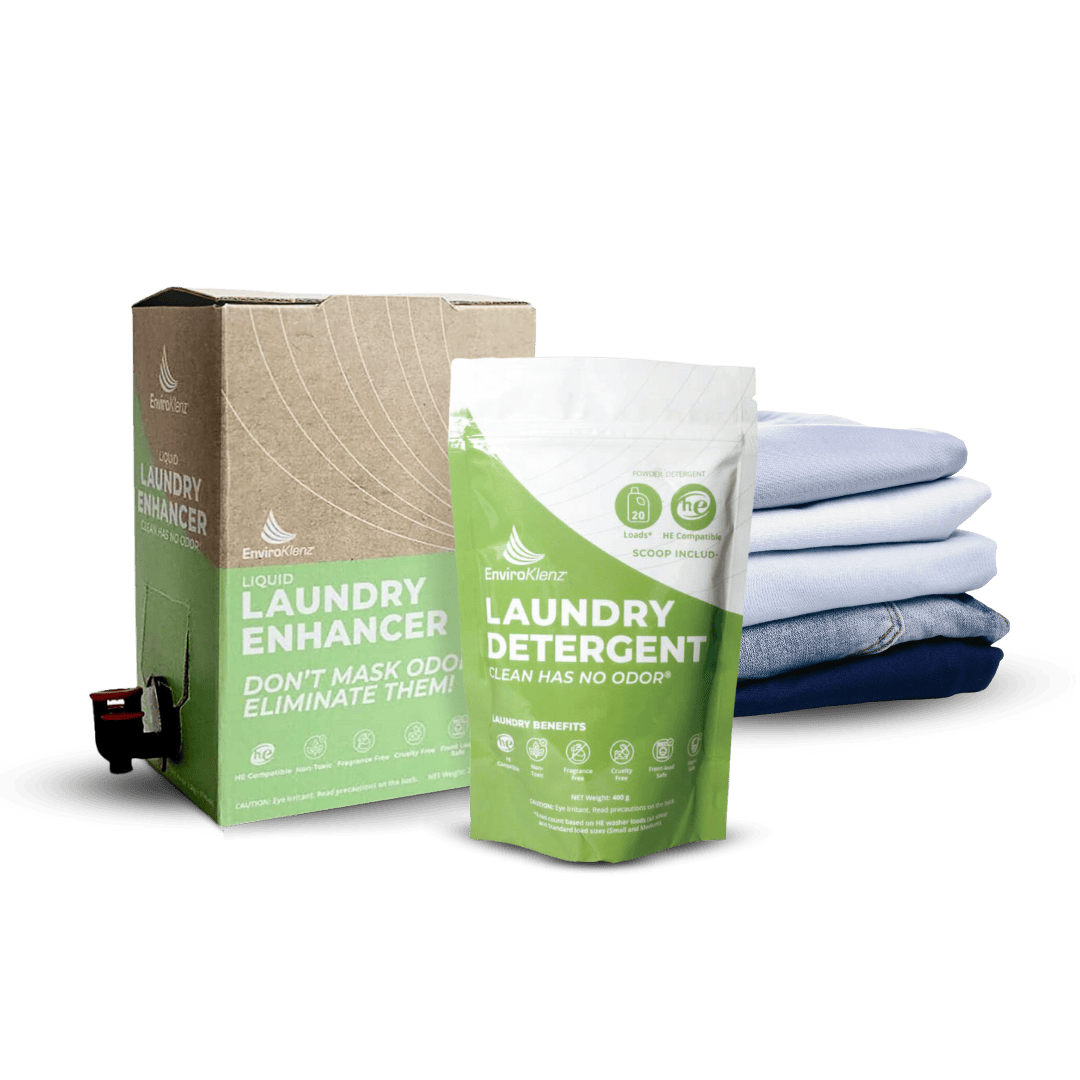Most of us don’t think twice about the ingredients in our laundry detergent. We assume if our clothes come out clean and smell good, everything’s fine, right? Wrong. The truth is, that many conventional laundry detergents are filled with toxic chemicals that not only irritate your skin but also harm the environment. From hormone-disrupting phthalates to cancer-causing 1,4-dioxane, these ingredients pose serious risks to your health and the planet.
Let’s dive into the most dangerous chemicals found in traditional detergents and why switching to a safer, laundry detergent without harsh chemicals like EnviroKlenz Laundry Products is crucial for you and your family.
1. Alkylphenol Ethoxylates (APEs)
Alkylphenol Ethoxylates (APEs) are used in many commercial detergents as surfactants to break down grease and dirt. Unfortunately, they also break down into highly toxic byproducts like nonylphenol, which can persist in the environment for decades. APEs are known to accumulate in aquatic animals, where they can cause reproductive harm and disrupt hormonal systems. According to the California Department of Toxic Substances Control, male fish exposed to these chemicals often develop female characteristics, affecting entire populations.
Fact: California estimates that over two million pounds of APEs are released into wastewater treatment plants each year, primarily from laundry detergents.
2. Volatile Organic Compounds (VOCs)
VOCs are found in many household products, including laundry detergents. These compounds evaporate into the air, where they can be inhaled, leading to respiratory problems and even cancer. A recent study published in Environmental Science & Technology found that more than 100 common household products, including laundry detergents, release VOCs that are known to cause health issues.
Fact: VOCs contribute to poor indoor air quality and have been linked to increased asthma rates, particularly in children. Using products with fewer VOCs, like EnviroKlenz, can help reduce exposure.
3. Phosphates
Phosphates are added to detergents to help soften water and improve cleaning effectiveness. However, when phosphates enter waterways, they trigger the growth of harmful algae blooms that deplete oxygen levels, killing fish and other aquatic life in the process. This process, called eutrophication, leads to dead zones in lakes and oceans, contributing to widespread environmental damage.
Fact: Even though phosphates are banned in household laundry detergents in several states, they are still allowed in some commercial-grade products.
4. 1,4-Dioxane
A probable human carcinogen, 1,4-Dioxane is commonly found in laundry detergents as a by-product of manufacturing processes. Despite its toxicity, it’s not required to be listed on ingredient labels, meaning most consumers aren’t even aware they’re being exposed. 1,4-Dioxane is linked to liver and kidney damage and is particularly harmful to aquatic ecosystems, where it can persist for long periods of time.
Fact: New York is one of the few states that have regulated 1,4-Dioxane in household cleaning products, but it’s still present in many detergents across the U.S.
5. Synthetic Fragrances
The appealing scents of conventional laundry detergents often come from synthetic fragrances made from a cocktail of chemicals like phthalates. These chemicals are not only linked to hormone disruption but can also trigger allergic reactions, asthma, and skin irritation. Synthetic fragrances release VOCs, which contribute to poor indoor air quality and can impact both human health and the environment.
Fact: EnviroKlenz Laundry Products are completely fragrance-free, making them a safer choice for families with sensitive skin or allergies. According to SkinSafe, EnviroKlenz products are hypoallergenic and free from known irritants.
Why You Should Switch to EnviroKlenz Laundry Products
Switching to a non-toxic detergent and a detergent without harsh chemicals like EnviroKlenz Laundry Products is one of the easiest ways to avoid harmful chemicals while still ensuring your clothes come out clean and fresh. EnviroKlenz uses Earth Mineral Technology, which neutralizes odors and chemicals at the molecular level—without relying on toxic additives like APEs, VOCs, and phosphates.
- Chemical-Free: EnviroKlenz is free from harmful ingredients like APEs, 1,4-Dioxane, and synthetic fragrances. Instead, it relies on earth minerals to break down and neutralize odors safely.
- Safe for Sensitive Skin: EnviroKlenz is hypoallergenic and contains no harsh chemicals, making it a perfect option for those with skin sensitivities. According to SkinSafe, it is rated as safe for sensitive skin, free from irritants like dyes and fragrances.
- Eco-Friendly Packaging: In addition to being free from toxic chemicals, EnviroKlenz also leads in sustainability with its innovative packaging that uses 86% less plastic than traditional laundry bottles.

EnviroKlenz: Safe, Non-Toxic, and Eco-Friendly Laundry Solutions
The chemicals in traditional detergents don’t just harm your clothes—they can also impact your health and the environment. By switching to a laundry detergent without harsh chemicals like EnviroKlenz, you can eliminate harmful toxins from your laundry routine and make a positive impact on your household and the planet.
EnviroKlenz’s unique Earth Mineral Technology ensures that your laundry is free from chemical residues, making it safer for you, your family, and the environment. With fragrance-free, non-toxic ingredients and a sustainably focused packaging system, EnviroKlenz stands out as a leader in safe, eco-conscious laundry care.
EnviroKlenz® Medical Disclaimer:
“Any information that is provided on this website is not for the use by any commercial or personal entity without expressed written consent of the blog author. The material and statements illustrated within this blog are not intended to diagnose, treat, cure, or prevent any diseases or medical conditions. Nor does the author in any way guarantee or validate the validity, totality, or efficacy of any claims and will therefore not be held responsible for the content of any claims. Always consult your medical physician for any specific medical advice or recommendations.”









